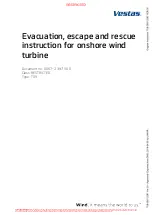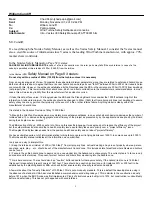
AIR 40, AIR Breeze, AIR 30, AIR X MARINE and AIR SILENT-X are trademarks of Primus Wind Power 2013 Primus Wind Power Inc..
AIR Owner’s Manual 3-CMLT-2020-A
35
BENCH TEST
(continued):
TEST 2 Power Up Test
1.) Remove blade/hub assembly from turbine and place in a safe location.
2.) Connect the turbine power wires to the appropriate terminals on your
battery: RED= Positive, BLACK = Negative.
3.)
Each time the AIR wind turbine is connected to a battery, the LED will
blink twice. The Air 40/Air Breeze LED will come on for two seconds, go
off for two seconds and come back on for four seconds to indicate that the
controller is running properly. The Air 30/Air X and older Air Breeze tur-
bines, depending on the code revision, will have the same blink cycle as
the Air 40/Air Breeze or will have a shorter set of blinks (roughly ½ second
per blink). You may need to wait 10 seconds between iterations of this
test in order to let the turbine discharge completely. The turbine is in
Brake Mode while initializing the controller. If the LED does not blink when
the AIR wind turbine is connected to a battery, you should contact your
turbine dealer or Primus Wind Power.
TEST 3 Spin Test
1.) Remove blade/hub assembly from turbine and place in a safe location
2.) With the AIR wind turbine connected to your battery bank, use an electric
drill to spin the rotor shaft while observing the LED. A short length cut from
the 5/16 inch hex key wrench can serve as a drive if necessary.
3.) Below 400 RPM, the rotor should spin freely and the LED should remain
off.
4.) At 460 RPM and above, the AIR wind turbine should be charging the
battery
. At this point, current should be present and can be measured
using an appropriate meter, measure in milli-amps in addition to volts.
(note: only small amounts of current will be present until higher RPM’s
(approximately 700 RPM) are attained). There should be resistance on the
rotor shaft and the LED should turn on. If the shaft is cogging (intermittent
resistance) or the turbine is consuming power, contact your turbine deal-
er or Primus Wind Power. Be sure your battery voltage is not high enough
to activate the regulation mode during this test (LED will blink).
TEST 4 Stator Test
1.) Remove the face assembly by removing the 3 face bolts. Noting which
wires go where for reassembly, remove the stator wires from the circuit
card. From left to right, the wire sequence should be 2-3-1.
2.) With none of the 3 stator wires touching one another, spin the rotor
quickly with your hand. It should spin easily. Repeat this touching wires 1
and 2 together. There should be a noticeable difference in rotational re-
sistance. Repeat with wires 2 and 3 and then 1 and 3. These 3 scenarios
should have the same rotational resistance. With all 3 wires touching, the
rotational resistance should be increased.
3.) If possible, take pictures of the inside of the turbine including the slip
rings and the circuit card/brushes from different perspectives to see
around the yaw assembly. Note any other observations of damage or
wear.
NOTE: If the turbine failed one or more of the bench tests, contact Primus Wind Power technical support at 303-242-5820 x 3 or
on tower and bench tests (as well as any other behavior details). Please include the serial number, product number, and voltage with all correspondence. Technical support may ask to
investigate further by opening the turbine and testing the stator (per below). Primus offers in house repair services as well as parts for field repair.
































